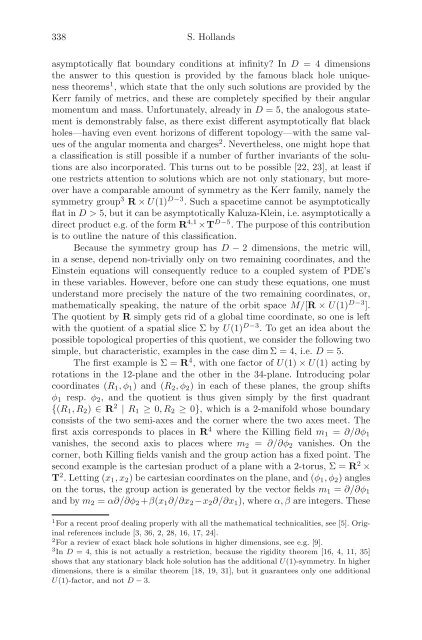Quantum Field Theory and Gravity: Conceptual and Mathematical ...
Quantum Field Theory and Gravity: Conceptual and Mathematical ...
Quantum Field Theory and Gravity: Conceptual and Mathematical ...
You also want an ePaper? Increase the reach of your titles
YUMPU automatically turns print PDFs into web optimized ePapers that Google loves.
338 S. Holl<strong>and</strong>s<br />
asymptotically flat boundary conditions at infinity? In D = 4 dimensions<br />
the answer to this question is provided by the famous black hole uniqueness<br />
theorems 1 , which state that the only such solutions are provided by the<br />
Kerr family of metrics, <strong>and</strong> these are completely specified by their angular<br />
momentum <strong>and</strong> mass. Unfortunately, already in D = 5, the analogous statement<br />
is demonstrably false, as there exist different asymptotically flat black<br />
holes—having even event horizons of different topology—with the same values<br />
of the angular momenta <strong>and</strong> charges 2 . Nevertheless, one might hope that<br />
a classification is still possible if a number of further invariants of the solutions<br />
are also incorporated. This turns out to be possible [22, 23], at least if<br />
one restricts attention to solutions which are not only stationary, but moreover<br />
have a comparable amount of symmetry as the Kerr family, namely the<br />
symmetry group 3 R × U(1) D−3 . Such a spacetime cannot be asymptotically<br />
flat in D>5, but it can be asymptotically Kaluza-Klein, i.e. asymptotically a<br />
direct product e.g. of the form R 4,1 ×T D−5 . The purpose of this contribution<br />
is to outline the nature of this classification.<br />
Because the symmetry group has D − 2 dimensions, the metric will,<br />
in a sense, depend non-trivially only on two remaining coordinates, <strong>and</strong> the<br />
Einstein equations will consequently reduce to a coupled system of PDE’s<br />
in these variables. However, before one can study these equations, one must<br />
underst<strong>and</strong> more precisely the nature of the two remaining coordinates, or,<br />
mathematically speaking, the nature of the orbit space M/[R × U(1) D−3 ].<br />
The quotient by R simply gets rid of a global time coordinate, so one is left<br />
with the quotient of a spatial slice Σ by U(1) D−3 . To get an idea about the<br />
possible topological properties of this quotient, we consider the following two<br />
simple, but characteristic, examples in the case dim Σ = 4, i.e. D =5.<br />
The first example is Σ = R 4 , with one factor of U(1) × U(1) acting by<br />
rotations in the 12-plane <strong>and</strong> the other in the 34-plane. Introducing polar<br />
coordinates (R 1 ,φ 1 )<strong>and</strong>(R 2 ,φ 2 ) in each of these planes, the group shifts<br />
φ 1 resp. φ 2 , <strong>and</strong> the quotient is thus given simply by the first quadrant<br />
{(R 1 ,R 2 ) ∈ R 2 | R 1 ≥ 0,R 2 ≥ 0}, which is a 2-manifold whose boundary<br />
consists of the two semi-axes <strong>and</strong> the corner where the two axes meet. The<br />
first axis corresponds to places in R 4 where the Killing field m 1 = ∂/∂φ 1<br />
vanishes, the second axis to places where m 2 = ∂/∂φ 2 vanishes. On the<br />
corner, both Killing fields vanish <strong>and</strong> the group action has a fixed point. The<br />
second example is the cartesian product of a plane with a 2-torus, Σ = R 2 ×<br />
T 2 . Letting (x 1 ,x 2 ) be cartesian coordinates on the plane, <strong>and</strong> (φ 1 ,φ 2 )angles<br />
on the torus, the group action is generated by the vector fields m 1 = ∂/∂φ 1<br />
<strong>and</strong> by m 2 = α∂/∂φ 2 +β(x 1 ∂/∂x 2 −x 2 ∂/∂x 1 ), where α, β are integers. These<br />
1 For a recent proof dealing properly with all the mathematical technicalities, see [5]. Original<br />
references include [3, 36, 2, 28, 16, 17, 24].<br />
2 For a review of exact black hole solutions in higher dimensions, see e.g. [9].<br />
3 In D = 4, this is not actually a restriction, because the rigidity theorem [16, 4, 11, 35]<br />
shows that any stationary black hole solution has the additional U(1)-symmetry. In higher<br />
dimensions, there is a similar theorem [18, 19, 31], but it guarantees only one additional<br />
U(1)-factor, <strong>and</strong> not D − 3.



![arXiv:1001.0993v1 [hep-ph] 6 Jan 2010](https://img.yumpu.com/51282177/1/190x245/arxiv10010993v1-hep-ph-6-jan-2010.jpg?quality=85)


![arXiv:1008.3907v2 [astro-ph.CO] 1 Nov 2011](https://img.yumpu.com/48909562/1/190x245/arxiv10083907v2-astro-phco-1-nov-2011.jpg?quality=85)








![arXiv:1002.4928v1 [gr-qc] 26 Feb 2010](https://img.yumpu.com/41209516/1/190x245/arxiv10024928v1-gr-qc-26-feb-2010.jpg?quality=85)
![arXiv:1206.2653v1 [astro-ph.CO] 12 Jun 2012](https://img.yumpu.com/39510078/1/190x245/arxiv12062653v1-astro-phco-12-jun-2012.jpg?quality=85)
